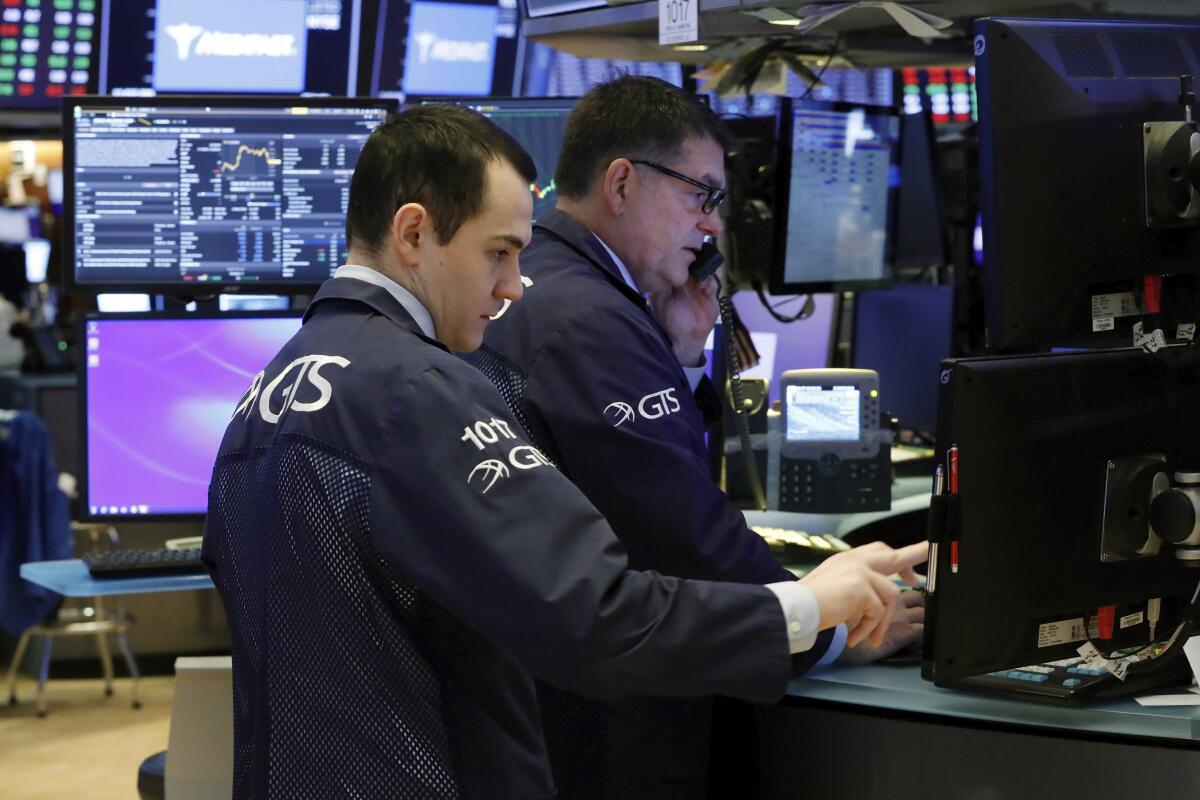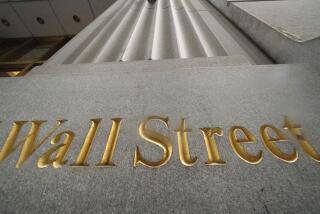U.S. stocks jump, erasing some of last week’s drop

- Share via
The Dow Jones industrial average soared nearly 1,300 points, or 5%, on Monday as stocks roared back from a seven-day rout on hopes that central banks will take action to shield the global economy from the effects of the coronavirus outbreak.
The huge gains clawed back some of the ground the market lost last week in a sell-off that gave stocks their worst stretch since the 2008 financial crisis.
Technology companies led Monday’s broad gains, which gave the Dow its largest-ever point gain and largest percentage increase since March 2009. The benchmark Standard & Poor’s 500 index jumped 4.6%, its best day since December 2018. The Nasdaq climbed 4.5%. Still, the indexes remain in the red for the year.
Bond prices fell, pushing yields up after the yields touched another record low earlier in the day. The yield on the 10-year Treasury note rose to 1.15% from Friday’s 1.12%.
The virus outbreak that began in central China has been shutting down industrial centers, emptying shops and severely crimping travel all over the world. More companies are warning investors that their finances will take a hit because of disruptions to supply chains and sales.
As the outlook worsens, investors are increasingly anticipating that the Federal Reserve and other major central banks around the world will lower interest rates or take other steps to shield the global economy from the effects of the outbreak.
“Investors have convinced themselves that global central banks will likely be even more accommodative in order to short-circuit any psychological damage, ” said Sam Stovall, chief investment strategist at CFRA.
Bill Nelson, chief economist at the Bank Policy Institute and a former Fed economist, said the Fed and other major central banks — possibly including China’s — could announce coordinated rate cuts by Wednesday morning. The cut would at least be half a percentage point and perhaps even three-quarters of a point, he said. “The only way to get a positive market reaction is to deliver more than expected.”
The International Monetary Fund and World Bank announced simultaneously Monday that they are ready to help countries affected by the coronavirus through their emergency lending programs and other tools. “We will use our available instruments to the fullest extent possible,” the IMF managing director, Kristalina Georgieva, and World Bank President David Malpass said in a joint statement. “International cooperation is essential.”
And Christine Lagarde, the head of the European Central Bank, said Monday that Europe’s top monetary authority is ready to take “appropriate and targeted measures” if necessary to support the economy against the head winds from the new coronavirus.
The statements echoed similar promises to act if necessary from the Federal Reserve on Friday and the Bank of Japan over the weekend. Traders have priced in a 100% probability that the Fed will cut rates by half a percentage point during or before its March meeting.
One encouraging sign to traders is that the finance ministers and central bank leaders of the Group of 7 major industrial countries will hold a conference call Tuesday to discuss an economic response to the viral outbreak. U.S. Treasury Secretary Steven T. Mnuchin and Federal Reserve Chairman A. Jerome Powell will lead the call. The group includes Japan, Germany, Britain and France, among others. The G-7 often issues statements pledging cooperation amid global economic turbulence.
There were signs the economic effect of the outbreak was continuing to mount. A measure of China’s manufacturing output dived last month to its lowest level on record as the outbreak closed factories and disrupted supply chains.
And the Organization for Economic Cooperation and Development, a research group made up mostly of advanced economies, said Monday that the viral outbreak “presents the global economy with its greatest danger since the financial crisis” in 2008.
The OECD cut its world growth forecast and said that even if there are only limited outbreaks outside China, the global economy will grow just 2.4% this year, the weakest since the crisis. That forecast matches several private estimates. If other countries are hit with outbreaks similar to China’s, growth could fall as low as 1.5%, the OECD said.
Separately, economists at Goldman Sachs slashed their forecasts for U.S. economic growth to 0.9% in the current quarter and to zero for the April-through-June quarter.
For investors, the great amount of uncertainty over how consumer behavior and spending will be affected has been unsettling.
“It’s not a typical economic blow,” said Bill Strazzullo of Bell Curve Trading. “What if major cities are on some kind of a lockdown? What will that do to restaurants, entertainment, shopping, travel? It’s almost impossible to game this out.”
Last week’s rout knocked every major U.S. index into a correction — a fall of 10% or more from a recent peak. Market watchers had said for months that stocks were overpriced and long overdue for another pullback.
The last time the market had a drop of that size was in late 2018, when the U.S.-China trade war was escalating and investors were worried about rising interest rates. With Monday’s surge, the S&P 500 is now 8.7% below the record high it reached Feb. 19.
But the fact that investors are holding on to Treasury notes at near record-low yields shows they are still worried.
“The fear factor is still very high,” said Kirk Hartman, president of Wells Fargo Asset Management. “Do you really want to own a 10-year Treasury at 1%? I don’t think so. I think this is a classic market in crisis.”
Coronavirus-fearing shoppers stocking up on everyday items helped lift shares in household goods companies. Costco jumped 10%. Walmart rose 7.6%. Procter & Gamble gained 5.6%.
Technology and healthcare stocks accounted for a big share of the gains. Apple climbed 9.3%. Gilead Sciences, a biotechnology company that has been testing one of its drugs as a potential treatment for the coronavirus, rose 8.7%.
Oil prices slumped about 15% last week as traders priced in the prospect of lower demand as a result of the virus outbreak. On Monday, benchmark U.S. crude rose $1.99, or 4.4%, to settle at $46.75 a barrel. Brent, the international standard, rose $2.23 to close at $51.90.
Gold rose $28.20 to $1,592.30 an ounce.
European benchmarks mostly rose, and Asian markets climbed broadly.
More to Read
Inside the business of entertainment
The Wide Shot brings you news, analysis and insights on everything from streaming wars to production — and what it all means for the future.
You may occasionally receive promotional content from the Los Angeles Times.










